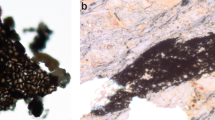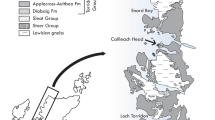Abstract
The existence of a terrestrial Precambrian (more than 542 Myr ago) biota has been largely inferred from indirect chemical and geological evidence associated with palaeosols1,2, the weathering of clay minerals3 and microbially induced sedimentary structures in siliciclastic sediments4. Direct evidence of fossils within rocks of non-marine origin in the Precambrian is exceedingly rare5,6. The most widely cited example comprises a single report of morphologically simple mineralized tubes and spheres interpreted as cyanobacteria, obtained from 1,200-Myr-old palaeokarst in Arizona5. Organic-walled microfossils were first described from the non-marine Torridonian (1.2–1.0 Gyr ago) sequence of northwest Scotland in 19077. Subsequent studies8,9,10 found few distinctive taxa—a century later, the Torridonian microflora is still being characterized as primarily nondescript “leiospheres”11. We have comprehensively sampled grey shales and phosphatic nodules throughout the Torridonian sequence. Here we report the recovery of large populations of diverse organic-walled microfossils extracted by acid maceration, complemented by studies using thin sections of phosphatic nodules that yield exceptionally detailed three-dimensional preservation. These assemblages contain multicellular structures, complex-walled cysts, asymmetric organic structures, and dorsiventral, compressed organic thalli, some approaching one millimetre in diameter. They offer direct evidence of eukaryotes living in freshwater aquatic and subaerially exposed habitats during the Proterozoic era. The apparent dominance of eukaryotes in non-marine settings by 1 Gyr ago indicates that eukaryotic evolution on land may have commenced far earlier than previously thought.
This is a preview of subscription content, access via your institution
Access options
Subscribe to this journal
Receive 51 print issues and online access
$199.00 per year
only $3.90 per issue
Buy this article
- Purchase on Springer Link
- Instant access to full article PDF
Prices may be subject to local taxes which are calculated during checkout



Similar content being viewed by others
References
Ohmoto, H. Evidence in pre-2.2 Ga paleosols for the early evolution of atmospheric oxygen and terrestrial biota. Geology 24, 1135–1138 (1996)
Gutzmer, J. & Beukes, N. J. Earliest laterites and possible evidence for terrestrial vegetation in the Early Proterozoic. Geology 26, 263–266 (1998)
Kennedy, M., Droser, M., Mayer, L. M., Pevear, D. & Mrofka, D. Late Precambrian oxygenation; inception of the clay mineral factory. Science 311, 1446–1449 (2006)
Prave, A. R. Life on land in the Proterozoic: evidence from the Torridonian rocks of northwest Scotland. Geology 30, 811–814 (2002)
Horodyski, R. J. & Knauth, L. P. Life on land in the Precambrian. Science 263, 494–498 (1994)
Schopf, J. W. & Klein, C. The Proterozoic Biosphere (Cambridge Univ. Press, 1992)
Teall, J. J. H. in The Geological Structure of the North-west Highlands of Scotland (eds Peach, B. N. et al.) 288, plate LII (Memoirs of the Geological Society of Great Britain, 1907)
Downie, C. So-called spores from the Torridonian. Proc. Geol. Soc. Lond. 1600, 127–128 (1962)
Cloud, P. E. & Germs, A. New pre-Paleozoic nannofossils from the Stoer Formation (Torridonian), NW Scotland. Geol. Soc. Am. Bull. 82, 3469–3474 (1971)
Zhang, Z. Upper Proterozoic microfossils from the Summer Isles, N.W. Scotland. Palaeontology 25, 443–460 (1982)
Kinnaird, T. C. et al. The late Mesoproterozoic-early Neoproterozoic tectonostratigraphic evolution of NW Scotland: the Torridonian revisited. J. Geol. Soc. Lond. 164, 541–551 (2007)
Turnbull, M. J. M., Whitehouse, M. J. & Moorbath, S. New isotopic age determinations for the Torridonian, NW Scotland. J. Geol. Soc. Lond. 153, 955–964 (1996)
Parnell, J., Boyce, A. J., Mark, D., Bowden, S. & Spinks, S. Early oxygenation of the terrestrial environment during the Mesoproterozoic. Nature 468, 290–293 (2010)
Stewart, A. D. The Later Proterozoic Torridonian Rocks of Scotland: Their Sedimentology, Geochemistry and Origin (Memoirs of the Geological Society, no. 24, 2002)
Stewart, A. D. Greywacke sedimentation in the Torridonian of Colonsay and Oronsay. Geol. Mag. 99, 399–419 (1962)
Sutton, J. & Watson, J. Sedimentary structures in the epidotic grits of Skye. Geol. Mag. 97, 106–122 (1960)
Stewart, A. D. & Parker, A. Palaeosalinity and environmental interpretation of red beds from the late Precambrian (‘Torridonian’) of Scotland. Sedim. Geol. 22, 229–241 (1979)
Knoll, A. H., Javaux, E. J., Hewitt, D. & Cohen, P. Eukaryotic organisms in Proterozoic oceans. Phil. Trans. R. Soc. B 361, 1023–1038 (2006)
Meng, F., Zhou, C., Yin, L., Chen, Z. & Yuan, X. The oldest known dinoflagellates: morphological and molecular evidence from Mesoproterozoic rocks at Yongji, Shanxi Province. Chin. Sci. Bull. 50, 1230–1234 (2005)
Jankauskas, T. V., Mikhailova, N. S. & Hermann, T. N. in Mikrofossilii Dokembriya SSSR [Precambrian Microfossils of the USSR] 190 (Nauka, Leningrad, 1989)
Javaux, E. J., Knoll, A. H. & Walter, M. R. Morphological and ecological complexity in early eukaryotic ecosystems. Nature 412, 66–69 (2001)
Knoll, A. H. Microbiotas of the late Precambrian Hunnberg Formation, Nordaustlandet, Svalbard. J. Paleontol. 58, 131–162 (1984)
Butterfield, N. J. & Chandler, F. W. Palaeoenvironmental distribution of Proterozoic microfossils, with an example from the Agu Bay Formation, Baffin Island. Palaeontology 35, 943–957 (1992)
Mikhailov, K. V. et al. The origin of Metazoa: a transition from temporal to spatial cell differentiation. Bioessays 31, 758–768 (2009)
Butterfield, N. J. Modes of pre-Ediacaran multicellularity. Precambr. Res. 173, 201–211 (2009)
Blank, C. E. & Sánchez-Baracalo, P. Timing of morphological and ecological innovations in the cyanobacteria – a key to understanding the rise in atmospheric oxygen. Geobiology 8, 1–23 (2010)
Lenton, T. M. & Watson, A. J. Biotic enhancement of weathering, atmospheric oxygen and carbon dioxide in the Neoproterozoic. Geophys. Res. Lett. 31, 1–5 (2004)
Knauth, L. P. & Kennedy, M. J. The late Precambrian greening of the Earth. Nature 460, 728–732 (2009)
Spinks, S. C., Parnell, J. & Bowden, S. A. Reduction spots in the Mesoproterozoic age: implications for life in the early terrestrial record. Int. J. Astrobiol. 9, 209–216 (2010)
Hutchinson, G. E. The paradox of the plankton. Am. Nat. 95, 137–145 (1961)
Acknowledgements
J. Rosenberg produced the confocal laser scanning image (Supplementary Fig. 6a); we thank O. Green for preparation of phosphatic nodules at Oxford. We thank J. Antcliffe, R. Callow and S. Moorhouse for field assistance and the people of Scoraig and Bill (the boatman) for access to Cailleach Head. This research was supported by NASA grant NNX07AU79G (P.K.S.), NERC NE/G015716/1 (C.H.W.) and NERC NE/G524060/1 (L.B.).
Author information
Authors and Affiliations
Contributions
All authors contributed to the intellectual content, design and writing of the manuscript, and collection and study of phosphatic nodules. C.H.W. and P.K.S. collected the palynological samples. P.K.S. wrote an initial draft, prepared the photographic plates and produced the provisional taxonomic assessment. L.B. and C.H.W. drafted the figures.
Corresponding author
Ethics declarations
Competing interests
The authors declare no competing financial interests.
Additional information
All materials (rock sample, remaining organic residues, palynological slides, thin sections) are curated in the collections of the Centre for Palynology of the University of Sheffield, UK.
Supplementary information
Supplementary Information
This file contains Supplementary Figures 1-7 with legends and Supplementary Tables 1-2. (PDF 5122 kb)
Rights and permissions
About this article
Cite this article
Strother, P., Battison, L., Brasier, M. et al. Earth’s earliest non-marine eukaryotes. Nature 473, 505–509 (2011). https://doi.org/10.1038/nature09943
Received:
Accepted:
Published:
Issue Date:
DOI: https://doi.org/10.1038/nature09943
This article is cited by
-
Mid-latitudinal habitable environment for marine eukaryotes during the waning stage of the Marinoan snowball glaciation
Nature Communications (2023)
-
Global patterns and rates of habitat transitions across the eukaryotic tree of life
Nature Ecology & Evolution (2022)
-
Genomic and fossil windows into the secret lives of the most ancient fungi
Nature Reviews Microbiology (2020)
-
The ocean genome and future prospects for conservation and equity
Nature Sustainability (2020)
-
Weathering in a world without terrestrial life recorded in the Mesoproterozoic Velkerri Formation
Nature Communications (2019)
Comments
By submitting a comment you agree to abide by our Terms and Community Guidelines. If you find something abusive or that does not comply with our terms or guidelines please flag it as inappropriate.



